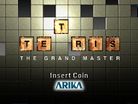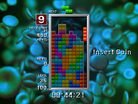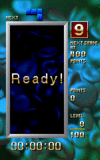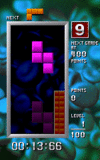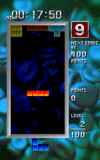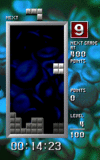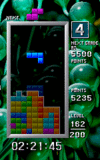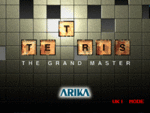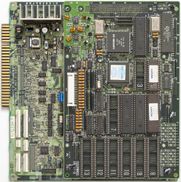Tetris The Grand Master
| Tetris The Grand Master | |
|---|---|
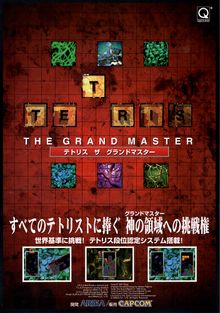 Arcade flyer for Tetris The Grand Master | |
| Developer(s) | Arika |
| Publisher(s) | Capcom, HAMSTER Co. |
| Platform(s) | Arcade, PlayStation 4, Nintendo Switch |
| Release | Arcade
|
| Sequel | Tetris The Absolute The Grand Master 2 |
| Gameplay info | |
| Next pieces | 1 |
| Playfield size | 10 × 20 |
| Hold piece | No |
| Hard drop | No |
| Rotation system | ARS |
Tetris The Grand Master (テトリス・ザ・グランドマスター[a]) is the inaugural game in the TGM series. Developed by Arika, it was first released in Japanese arcades in August 1998. On December 1, 2022, the game was made available for PlayStation 4 and Nintendo Switch as part of the Arcade Archives series.[1][2]
Players place pieces and clear lines as the game goes on, increasing their grade along the way. At later levels, the game will force them to keep up with the high speeds using special techniques, such as the Initial Rotation System introduced in the game.
Gameplay
TGM's gameplay is heavily inspired by its arcade predecessor, Sega's Tetris released 10 years earlier. It uses a modified rotation system, color scheme, and relies heavily on mechanics such as lock delay. Another game which inspired TGM is TETRIS SEMIPRO-68k, a fan game which was the first to introduce 20G gravity.
The main goal in TGM is to score points, awarding the player a higher grade. The game ends when a player reaches level 999. If the player scored enough points, they will be awarded with the grade S9. To achieve the grade GM, the player must also meet some time requirements during play. If the player tops out before reaching level 999, the game ends, awarding the player the current grade and its "mastering time", the time at which the grade was awarded during gameplay.
Level
Level has a unique implementation in TGM. The level counter will increase by 1 for every piece that enters the playfield. It will also increase by 1 for each line cleared.
When the player is about to increment the hundreds digit (e.g., level 399), only line clears will increase the level. Level 998 is treated similarly, with a final line clear required to reach 999 and finish.
IRS
- Main article: IRS
Abbreviation for Initial Rotation System.
Normally a piece will appear in the rotation showed in the piece preview. With IRS, holding either the left or right rotation button will cause the piece to appear rotated 90 degrees. This allows the player a higher degree of freedom when placing pieces at higher game speeds.
TLS
- Main article: ghost piece
Abbreviation for Temporary Landing System This system is a semi-transparent representation of where the piece will land if allowed to drop into the playfield. It is displayed up to level 100.
Buffer zone
Above the playfield, the game uses a single-row buffer zone, effectively extending the height of the playfield from 20 to 21. Row 21 allows blocks that lock in it to reappear once the stack is lowered. Any row above it, however, is not part of the buffer zone, meaning that blocks that lock in such rows get deleted and will not reappear once the stack is lowered.
Scoring
The Grand Master shares the same scoring mechanisms of many other Tetris games:
- The player receives more points for clearing more lines at once.
- Lines are worth more with each passing level.
- The player receives points for forcing a piece down. (Although only when this results in cleared lines, unlike in some other games.)
- The player receives a combo bonus for clearing lines with consecutive pieces.
- The player receives a bravo bonus for clearing the entire playfield.
Scoring formula
Where:
- Level is the current level the player is on (before the lines are cleared).
- Lines is the number of lines the player just cleared.
- is rounded up.
- Soft is the cumulative number of frames during which Down was held during the piece's active time. Manually locking pieces already on the ground will increase Soft by 1.
- Locking a piece without clearing lines resets Combo to 1. Otherwise, the game updates Combo as follows, before calculating Score:
- E.g., a double-triple-single combo will have combo values 3, 7, and 7 respectively.
- Bravo is equal to 4 if this piece has cleared the screen, and otherwise is 1.
Grading
In TGM grade is entirely determined by score. As the player passes certain milestones, the game will assign the player the next grade.
| Grade | Required Score | Grade | Required Score |
|---|---|---|---|
| 9 | 0 | S1 | 16,000 |
| 8 | 400 | S2 | 22,000 |
| 7 | 800 | S3 | 30,000 |
| 6 | 1,400 | S4 | 40,000 |
| 5 | 2,000 | S5 | 52,000 |
| 4 | 3,500 | S6 | 66,000 |
| 3 | 5,500 | S7 | 82,000 |
| 2 | 8,000 | S8 | 100,000 |
| 1 | 12,000 | S9 | 120,000 |
| Level | Required Score | Time |
|---|---|---|
| 300 | 12,000 (Grade 1) | <04:15:00 |
| 500 | 40,000 (Grade S4) | <07:30:00 |
| 999 | 126,000 (slightly higher than S9) |
<13:30:00 |
Secret grade
- Main article: Secret Grade Techniques
Secret grade is a hidden grading system that recognizes a ">" pattern in the playfield by leaving holes. The first hole becomes Secret grade 9, and each subsequent hole increasing the grade until row 19, the GM grade. The player must top out to have the Secret grade awarded. A minimum grade of 5 is needed to see the message.
Vs. Mode
If the arcade operator has enabled Vs. mode, two players can start a Vs. game. One player must first start a game, and during any point of that game the second player may press start to challenge them, and begin a game.
When the player clears 2 or more lines at once, those lines will be sent to their opponent's playfield as garbage lines. If the match does not end within 5 minutes, the game ends in a draw.
Item blocks
Item blocks can be used to attack or defend from the player's opponent. The player gets a random item with every 20 blocks placed, regardless of line clears.
Clearing lines will fill up the item meter adjacent to a player's playfield. When the meter is full an item block is dealt to the player. They may use it by clearing a line which the piece is part of.
It is possible to cancel active item blocks by activating an attack item before the opponent's block is placed. Note that purely visual attacks, such as X-Ray, Press Field and Spin Field, do not destroy enemy blocks.
There are 18 different item blocks.
| Attack items | |
|---|---|
| DEATH BLOCK | Makes the opponent's next block big. |
| NEGA FIELD | Flip the playfield's occupied cells to empty, and empty cells to occupied. |
| SPIN FIELD | Rotate the opponent's field for a short time. |
| 180° FIELD | Rotate the playfield upside down and move the newly rotated cells down. |
| SHOT GUN! | Randomly shoot a group of holes in the opponent's stack. |
| HARD BLOCK | The opponent's next piece must be cleared twice to be removed from the playfield. |
| LASER BLOCK | Remove a column of holes in the opponent's stack. The attacker many move the laser by pressing left and right. |
| ROLL ROLL | The opponent's next 3 pieces are auto rotating by a fixed interval. |
| TRANS FORM | The opponent's next 3 pieces will change tetromino every time the piece is rotated. |
| X-RAY | A partially invisible effect is applied to the opponent's stack for a short period. |
| PRESS FIELD | Shrinks the opponent's playfield for a short period. |
| Defense items | |
| ↑ DEL FIELD | Deletes the upper half of the player's playfield. |
| ↓ DEL FIELD | Deletes the lower half of the player's playfield. |
| → MOV FIELD | Push every cell in the player's playfield to the right. |
| ← MOV FIELD | Push every cell in the player's playfield to the left. |
| DEL EVEN | Deletes every 2nd row in the player's playfield. |
| Special items | |
| FREE FALL | Forces all cells to move down in the player's playfield removing any holes. |
| EXCHG FIELD | Swaps the player's and opponent's playfield. |
Hidden modes
All codes must be entered at the title screen. Codes may be combined (i.e. Big 20G mode + Reverse Monochrome mode.) Scores achieved using codes will not be stored on the high score table.
Key: L = Left, D = Down, U = Up, R = Right
Other modes
- No item VS (Play VS mode without item blocks):
Hold both player Start buttons together before the match begins.
Speed timings
Gravity does not increase uniformly, unlike many other tetris games. It rises and falls, depending on the level as shown in the table below.
The unit for gravity is G (rows per frame), as a fraction with a constant denominator of 256. This means G = Internal Gravity/256. For example, at levels 90 through 99, the gravity is 64/256G, or 1/4G.
| Level | Internal Gravity (1/256 G) |
Level | Internal Gravity (1/256 G) |
|---|---|---|---|
| 0 | 4 | 220 | 32 |
| 30 | 6 | 230 | 64 |
| 35 | 8 | 233 | 96 |
| 40 | 10 | 236 | 128 |
| 50 | 12 | 239 | 160 |
| 60 | 16 | 243 | 192 |
| 70 | 32 | 247 | 224 |
| 80 | 48 | 251 | 256 (1G) |
| 90 | 64 | 300 | 512 (2G) |
| 100 | 80 | 330 | 768 (3G) |
| 120 | 96 | 360 | 1024 (4G) |
| 140 | 112 | 400 | 1280 (5G) |
| 160 | 128 | 420 | 1024 (4G) |
| 170 | 144 | 450 | 768 (3G) |
| 200 | 4 | 500 | 5120 (20G) |
Unlike TGM2, the line clear delay, lock delay, ARE and DAS do not change throughout the game. The following are the timing values adjusted to what a player would observe, including inclusive DAS counting.
| Level | ARE (frames) |
DAS (frames) |
Lock (frames) |
Line clear (frames) |
|---|---|---|---|---|
| 000 - 999 | 30 | 16 | 30 | 41 |
- The player's DAS charge is unmodified during line clear delay, the first 4 frames of ARE, the last frame of ARE, and the frame on which a piece spawns.
Arcade Archives version
The Arcade Archives version released for the Nintendo Switch and PS4 features new modes and online leaderboards.
Original mode
A replica of the original arcade release.
Hi score mode
A mode where you compete for the highest grade possible in the shortest amount of time. 20G mode can be enabled.
Caravan mode
A mode where you attempt to get the highest score in 5 minutes. Big Block mode can be enabled.
Emulation
The tables below provide verified lists of archives and files to make sure that Tetris the Grand Master can be emulated properly. There aren't any guides, at this point, for dumping these required files from a PCB; but these files can be searched out on the Internet.
| Archive | MD5 Hash |
|---|---|
| tgmj.zip | 7fcc8a72b4bc1f3340e1db4724b0628d |
| coh3002c.zip | 4f97958fe67444637b5c6700fb62849c |
| cpzn2.zip | 99304c05983b337217ab4b56400a14ac |
| qsound_hle.zip | 758388893761ea3ff0d820f60344a38e |
| File | MD5 Hash |
|---|---|
| cp10.ic652 | 26574f621b61ea09eef08e8a7eba5a65 |
| m534002c-59.ic353 | 1254b215f64aee1f83895e0213a9ac82 |
| coh-3002c.353 | 1254b215f64aee1f83895e0213a9ac82 |
| dl-1425.bin | 108b113a596e800a02fece73f784eeb0 |
| File | MD5 Hash |
|---|---|
| ate_02.2e | 591fe13727496e4037e53cc834e24ccd |
| ate-01m.3a | b832063bef8d81ff6a318f39da6f4c74 |
| ate-05m.3h | 99740df1cf1201a4efe5d5b2c4806425 |
| ate-06m.4h | 2188d3a9be4769a21e44d33cbfbd2024 |
| atej_04.2h | 14e13f937163b6db734d3220a017bfc0 |
| cp11 | 439f9c44559f2f4761d433dd4b96866d |
The current version of MAME is capable of running Tetris the Grand Master. MAME can either be run as a standalone program on Windows or the Macintosh, or as a core through other Emulator frontends such as RetroArch or OpenEmu (Experimental). It is recommended that all of the BIOS files from the above archives are added into the "tgmj.zip" archive before importing the game into an emulator. If the tgmj.zip archive is imported without the BIOS files inside, the emulator will report numerous file requirement errors, or it will simply not start.
Physical scans
See also
Notes
- ↑ Japanese: Tetorisu Za Gurando Masutā
References
- ↑ "The hardest Tetris game is officially coming to consoles for the first time". VGC. 2022-11-22. Archived from the original on 2022-11-22. Retrieved 2022-11-23.
- ↑ "“Akeaka” 300-shū renzoku haishin tassei o kinen shite “akeaka gyarakushian” o 11 tsuki 24-nichi,“akeaka tetorisu za gurandomasutā” o 12 tsuki 1-nichi ni haishin!" [In commemoration of the achievement of 300 consecutive weeks of "Ake Aca" distribution, "Ake Aca Galaxian" will be distributed on November 24th, and "Ake Aca Tetris The Grandmaster" will be distributed on December 1st!]. Famitsu. 2022-11-22. Archived from the original on 2022-11-22. Retrieved 2022-11-22.
External links
| ||||||||||||||||||||
